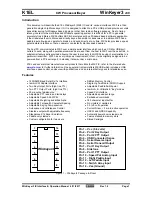
13 SeRial inTeRFaCe
S1C63003/004/008/016 TeChniCal Manual
Seiko epson Corporation
13-9
(Rev. 1.1)
i/O Memory of Serial interface
13.8
Table 13.8.1 shows the I/O addresses and the control bits for the serial interface.
8.1 Control bits of serial interface
Table 13.
Address
Register name R/W Default
Setting/data
Function
FF14H
(
*
6)
D3 0 (
*
3)
R
– (
*
2)
–
Unused
D2
SiFCKS2
R/W
0
7 f
3
/4
4 PT1
1 f
1
Serial I/F clock frequency selection
(f
1
= f
OSC1
, f
3
= f
OSC3
)
D1
SiFCKS1
R/W
0
6 f
3
/2
3 f
1
/4
0 Off/
External
D0
SiFCKS0
R/W
0
5 f
3
2 f
1
/2
FF58H
(
*
6)
D3 0 (
*
3)
R
– (
*
2)
–
Unused
D2
eSOuT
R/W
0
1 Enable
0 Disable
SOUT enable
D1
SCTRG
R/W
0
1 Trigger (W)
Run (R)
0 Invalid (W)
Stop (R)
Serial I/F clock trigger (writing)
Serial I/F clock status (reading)
D0
eSiF
R/W
0
1 SIF
0 I/O
Serial I/F enable (P3 port function selection)
FF59H
(
*
6)
D3
SCPS1
R/W
0
3 Negative,
↑
1 Positive,
↓
Serial I/F clock format selection
(polarity, phase)
D2
SCPS0
R/W
0
2 Negative,
↓
0 Positive,
↑
D1
SDP
R/W
0
1 MSB first
0 LSB first
Serial I/F data input/output permutation
D0
SMOD
R/W
0
1 Master
0 Slave
Serial I/F mode selection
FF5AH
(
*
6)
D3 0 (
*
3)
R
– (
*
2)
–
Unused
D2 0 (
*
3)
R
– (
*
2)
–
Unused
D1
eSReaDY
R/W
0
1 SRDY
0 SS
SRDY_SS function selection (ENCS = "1")
D0
enCS
R/W
0
1 SRDY_SS
0 P33
SRDY_SS enable (P33 port function selection)
FF5BH
(
*
6)
D3
SD3
R/W
×
0H–FH
Serial I/F transmit/receive data
(low-order 4 bits)
SD0 = LSB
D2
SD2
R/W
×
D1
SD1
R/W
×
D0
SD0
R/W
×
FF5CH
(
*
6)
D3
SD7
R/W
×
0H–FH
Serial I/F transmit/receive data
(high-order 4 bits)
SD7 = MSB
D2
SD6
R/W
×
D1
SD5
R/W
×
D0
SD4
R/W
×
*
1 Initial value at initial reset
*
2 Not set in the circuit
*
3 Constantly "0" when being read
*
4 Unused in the S1C63003/004/008
*
5 Unused in the S1C63003/004
*
6 Unused in the S1C63003
SiFCKS[2:0]: Serial interface clock frequency select register (FF14h•D[2:0])
Selects the synchronous clock frequency in master mode.
8.2 Serial interface clock frequencies
Table 13.
SIFCKS[2:0]
SIF clock (master mode)
7
f
OSC3
/ 4
*
6
f
OSC3
/ 2
*
5
f
OSC3
/ 1
*
4
Programmable timer 1
*
3
f
OSC1
/ 4 (8 kHz)
2
f
OSC1
/ 2 (16 kHz)
1
f
OSC1
/ 1 (32 kHz)
0
Off (slave mode)
*
f
OSC1
: OSC1 oscillation frequency. ( ) indicates the frequency when f
OSC1
= 32 kHz.
f
OSC3
: OSC3 oscillation frequency
*
The maximum clock frequency is limited to 1 MHz.
When programmable timer 1 is selected, the programmable timer 1 underflow signal is divided by 2 before it is
used as the synchronous clock. In this case, the programmable timer must be controlled before operating the serial
interface. Refer to the "Programmable Timer" chapter for controlling the programmable timer.
Fix at "0" in slave mode.
At initial reset, this register is set to "0."
















































